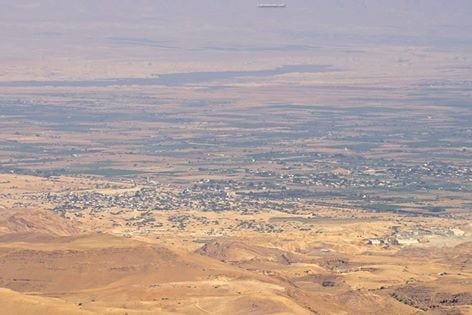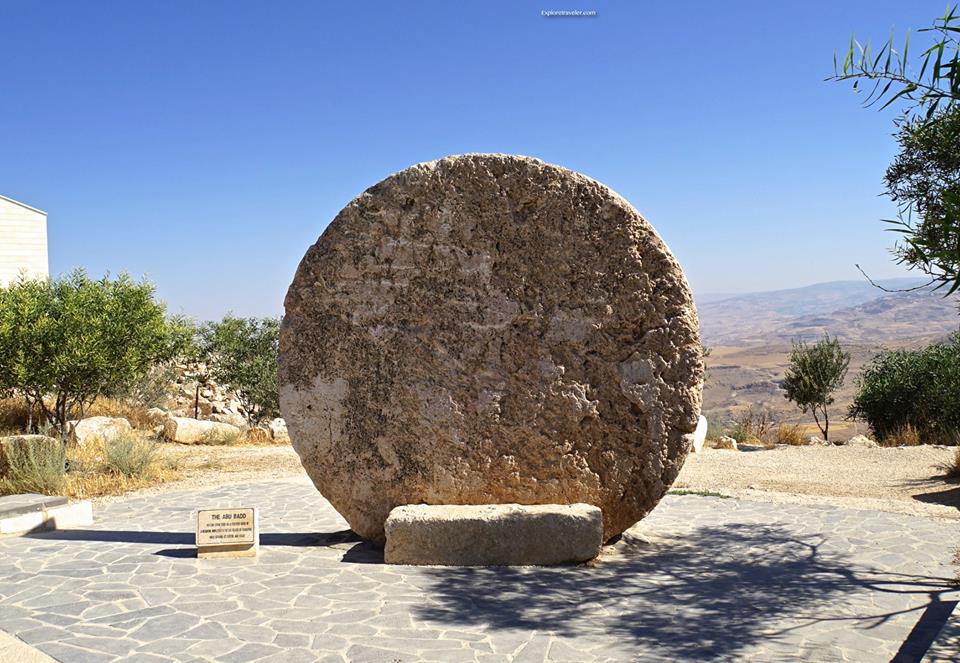
Mount Nebo Adventure
The Promised Land as Seen by Moses on the top of Mount Nebo in Jordan is breathtaking. Mount Nebo is over 3,000 feet high and is just NW of Madaba across from the Northernmost part of the Dead Sea. According to ancient tradition, it was from Mount Nebo that Moses looked out over “The Promised Land” before he died. We have the account of this experience recorded for us in the 34th chapter of the Book of Deuteronomy in the Hebrew Scriptures.
“Then Moses climbed Mount Nebo from the plains of Moab to the top of Pisgah, across from Jericho. There the Lord showed him the whole land… Then the Lord said to him, “This is the land I promised on oath to Abraham, Isaac, and Jacob when I said, ‘I will give it to your descendants.’ I have let you see it with your eyes, but you will not cross over into it.”
“And Moses the servant of the Lord died there in Moab, as the Lord had said. He buried him in Moab, in the valley opposite Beth Peor, but to this day no one knows where his grave is.” Deuteronomy 34:1-6
Mount Nebo is an important site for Jews, Arabs, and Christians. Many visitors and pilgrims come to Jordan to visit this famous mountain in the land of Moab. Many Christians include this area in their pilgrimage to the Holy Land.
The site is owned and cared for by the Franciscan Order of the Roman Catholic Church. They have discovered many treasures from an earlier church on the site. They have found, not only significant remains of the early Byzantine Church itself but many magnificent Byzantine mosaics. At the current time, a small simple structure has been built over these remains to protect them. The site is dedicated to Moses.
As Far As The Eye Can See
As for as, the eye can see is the Holy Land as seen from Mount Nebo. It is amazing! Think about looking out over the side of Mount Nebo and seeing across the Holy Land and beyond. You literally see all of the Holy Land and even beyond its borders. Looking toward the north is the valley of the River Jordan. The West Bank and the city of Jericho can usually be seen from the summit. Also on a clear day, you can see the City of Jerusalem. What a magnificent view! What is the History of this astonishing view? Why is Mount Nebo so special? Come along with us as we explore the history of Jordan’s Mount Nebo.
In exploring the writings of the Fourth Century, we meet a Pilgrim Nun named Egeria. In her writings, she shares about a Sanctuary built on Mount Nebo to honor Moses. It is thought that this church was built on the site of an earlier sanctuary. This church was completed in the year 394. This large church had three apses or semicircles on the Eastside. The altar was located in the apses with arches and a domed roof. Two funeral chapels completed the building. One was on the Northside and the other on the South side. What a magnificent building it must have been!
During the Sixth Century, we see even more change and excitement for this small church. The church was enlarged and then made into a Basilica. The Basilica was completed with a sacristy and new baptistery. There are many surviving floor mosaics that date from c.530 AD. The mosaics are beautiful! Soon after, a large monastery was built and a pilgrimage center. This was a thriving Basilica and Monastery for over six centuries. The Pilgrimage Center was constantly in use. Many Muslims visit the Memorial Church of Moses each year. Moses is considered a prophet to Christians, Muslims, and Jews alike. Many pilgrimages continue to this day.
This outstanding site was mostly abandoned by 1564. It remained highly neglected for many centuries. It was purchased by the Franciscan Order in 1993. The site was then excavated and restored. The modern additions to the excavated church have been very simple. They are little more than a basic shelter that protects the excavations and ancient mosaic floors.
On March 19, 2000, Pope John Paul II was its first distinguished visitor. He came to the chapel during his pilgrimage to the Holy Land. While he was there he planted an Olive Tree next to the Benzidine Chapel For Peace.
Today, Mount Nebo is an active Franciscan Monastery. The Franciscan Archaeological Institute also has its headquarters within the Monastery. This is a special stop for both visitors and pilgrims. Many come every year to walk in the steps of Moses.
The Great Rock On Mount Nebo
The Great Stone on Mount Nebo is believed to be from the Tomb of Jesus. It stands today as a memorial to Moses. During recent years, the rock has been measured and found to fit the tomb exactly. The tomb also has the original stop for the rock when moved into place. Today it stands on the very spot that it is thought that Moses stood to look at the “Promised Land.” What a spectacular view!
Brazen Serpent Monument
A serpentine cross sculpture stands at the top of the Mountain. This was the creation of Italian artist Giovanni Fantoni. This monument is symbolic of the bronze serpent that was created by Moses in the wilderness. The words of Jesus in John 3:14 appear on the Monument.
“As Moses lifted up the serpent in the wilderness, so must the Son of Man be lifted up.”
The story of the bronze serpent is found in the Hebrew Bible in Numbers 21:4-9. The cross symbolizes the Cross on which Jesus was crucified. The words are recorded in the New Testament Scriptures in John 3:14.
The Ancient Baptistery
As you enter the Memorial Church of Moses on Mount Nebo, keep to the left for a magnificent surprise. You will see the excavated Baptistery complete with the most spectacular mosaics ever excavated. These magnificent mosaics can be skillfully dated to August 531, thanks to an inscription in Greek. It also lists the three workers on this project and the Bishop at the time it was built. The Bishop listed was Bishop Elias.
These amazing pristine mosaics were preserved in part, due to a second Baptistery that was laid over the top of the ancient Baptistery in 597. These spectacular mosaics remained undiscovered for over 1400 years. It was not until the excavation in 1976 that the first mosaic was found. It was restored and hangs on a wall.
These mosaics were very large squares that were divided into 4 real-life strips. These strips contained scenes of men and animals depicting a way of life. Each had a nice border. The top two sections depict extreme hunting scenes. The first scene shows a humble shepherd fighting a lion and the second a soldier in a fierce fight with a lioness. The other scene shows two horseback hunters engaged in a fight with a bear and a wild boar. All four of these mosaics show the precise detail of the artist.
The bottom scenes are very pastoral and calming. The first shows a shepherd watching after his sheep and goats while under the cover of a tree. The second depicts a darker-skinned man leading an Ostrich on a leash. Another scene shows a young boy with a Zebra on a leash. The final scene shows a large spotted animal that looks much like a camel, though it could also be a zebra.
There are many more mosaics hanging in the central section of the church and on the side aisles. There are many pieces of the almost 600 tiles that made up the magnificent mosaic pavement. One of the most outstanding and oldest mosaics is a braided cross that is displayed on the south wall. There are also many mosaics taken from the Church of George in Mukhiya. These mosaics have a very old Arabic script, though it is not yet clear which one or how old.
To one side of the Baptistry hangs an extraordinary mosaic cross. The cross was excavated from the original Fourth Century Church and now hangs on the new modern altar. Next to the altar is a photograph of the Pope praying at this modern altar. The cross is shown in the background.
Theotokos Chapel
As you prepare to exit the Memorial Church of Moses there is a simple chapel over three of the rooms of the old Monastery. In the semi-circles on the East side of the church is a mosaic of a square object that may be a vessel used for the Eucharist or maybe an altar canopy. The mosaic also features many bulls and gazelles. The floor of the chapel is laid with many original mosaics of plants and animals of the time period. All these shed light on what life was like during the fourth to the seventh centuries.
The Ancient Monastery
On the highest section of Mount Nebo, Syagha were found the complete remains of an ancient Byzantine church and the original monastery. These were found in the excavation of 1933. The walls of this ancient monastery can be seen as you exit and go outside.
Today the work of excavation continues as visitors and monks work and pray hand in hand. Morning and evening there is prayer in the monastery and all workers who desire are welcome to join. There are simple accommodations for a few workers at a time. During the day the many workers continue to locate the new treasure and categorize the previous treasure found. The work is exacting but many hands make the labor easier. There is an atmosphere of prayer and meditation as they work. Today’s life on Mount Nebo is guided by a principle of simplicity and hard work.
Caves on Mount Nebo
The Mount Nebo Mountain Range is home to many caves. Some of these caves are shallow and open and others are deep and closed off. One of the deepest mysteries of Mount Nebo is the whereabouts of the Ark of the Covenant. According to the ancient Hebrew writings of the Maccabees, it was hidden in a cave on Mount Pisgah, the highest peak in the Mount Nebo Mountain Range. According to Second Maccabees, Jeremiah carried the tent, the ark, and the incense altar into a cave on Mount Pisgah and then sealed the opening. The account in Second Maccabees reads as follows:
2 Maccabees 2:4-8
4″ These same records also tell us that Jeremiah, acting under divine guidance, commanded the Tent of the Lord’s Presence and the Covenant Box to follow him to the mountain where Moses had looked down on the land which God had promised our people.5 When Jeremiah got to the mountain, he found a huge cave, and there he hid the Tent of the Lord’s Presence, the Covenant Box, and the altar of incense. Then he sealed up the entrance.
6 Some of Jeremiah‘s friends tried to follow him and mark the way, but they could not find the cave.7 When Jeremiah learned what they had done, he reprimanded them, saying,
No one must know about this place until God gathers his people together again and shows them mercy.8 At that time he will reveal where these things are hidden, and the dazzling light of his presence will be seen in the cloud, as it was in the time of Moses and on the occasion when Solomon prayed that the Temple might be dedicated in holy splendor.”
Whatever your belief about the Ark of the Covenant, one thing is for certain, it is one of the possible mysteries of the Mount Nebo Mountain Range. Archaeologist Crotser, in the fall of 1981, is said to have found the ark and took pictures. No one has dared to touch it. They all remember what happened in the days of old when someone dared to touch this unique golden box. So for now, it still remains one of the mysteries of Mount Nebo in Jordan.
If you are looking for adventure, then consider Mount Nebo. Go beyond the Memorial Church of Moses and climb the beautiful mountain range. Explore all the ruins and treasures. Find the answer to many questions by spending time exploring the wonderful mosaics of the original baptistry. Grab your passport and pack your backpack. Get the necessary permissions if you want to hike the mountain range. A Jordanadventure is waiting in the Mount Nebo Mountain Range.
There is also an authorized post on seemit under @exploretraveler at: https://steemit.com/@exploretraveler
Treasures In The Old City Of Jerusalem
The Church Of The Nativity In Bethlehem Israel
The Church Of The Annunciation In Nazareth, Israel
Nazareth from the Mount of Precipice


